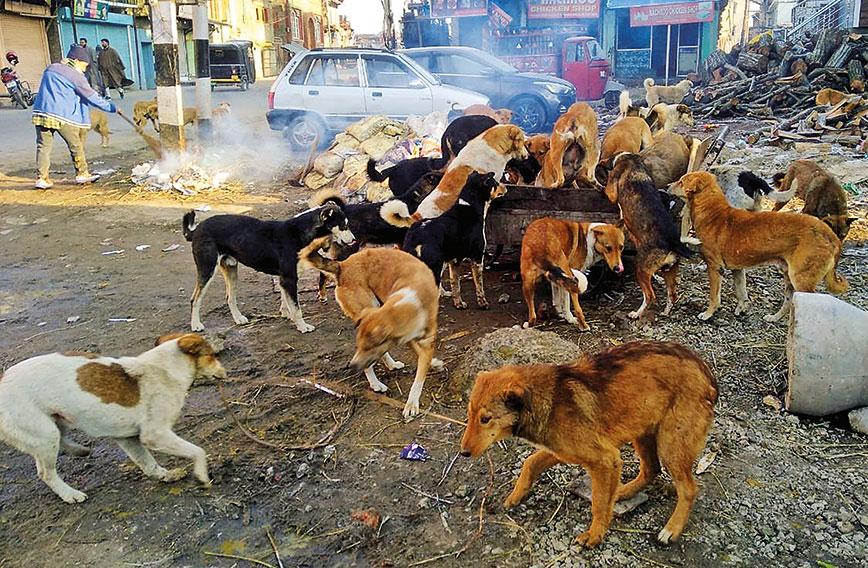A Neighborhood Under Siege
By: Javid Amin
Srinagar 11 April 2025: Imagine stepping outside your home and being greeted not by neighbors, but by a pack of snarling stray dogs. For residents of Jawahar Nagar, Rajbagh, and surrounding areas in Srinagar, this is a daily reality. What began as a minor inconvenience has spiraled into a full-blown public health and safety crisis. Streets once bustling with life now echo with barks and whimpers, as over 5,000 stray dogs (estimated by Srinagar Municipal Corporation in 2023) dominate neighborhoods, terrorizing children, seniors, and families. This article dives deep into the roots of the crisis, shares harrowing stories from locals, and demands actionable solutions to reclaim their right to safety.
01: The Human Toll – Voices from the Frontlines
“I Carry a Stick Just to Buy Milk”: Stories of Fear
- Mrs. Faheem, Rajbagh Resident:
“My 7-year-old daughter hasn’t played outside in months. Last week, a dog chased her into a corner until a shopkeeper intervened. Now, we carry sticks on walks. Is this what childhood should be?” - Mr. Bashir, Government Official:
“After sunset, the streets belong to the dogs. My elderly mother was bitten last month. The hospital bill? ₹8,000. The trauma? Endless.” - Ayesha Khan, School Teacher:
“Parents beg me to escort kids to school. Even our playgrounds aren’t safe. How do we explain this fear to children?”
By the Numbers: A Crisis Quantified
- Stray Population: 5,200+ dogs in Srinagar (SMC, 2023), doubling since 2018.
- Dog Bites: 1,240 reported cases in 2023 (Jawahar Nagar tops the list).
- Rabies Risk: 60% of strays unvaccinated; 12 human rabies deaths in Kashmir since 2020.
02: Roots of the Problem – How Did We Get Here?
The Perfect Storm
- Unchecked Breeding: A single female dog can produce 12–16 pups yearly. With minimal sterilization, Srinagar’s strays multiply unchecked.
- Waste Mismanagement: Open garbage bins and food waste attract dogs. Jawahar Nagar’s 40% uncollected waste (per SMC) fuels the crisis.
- Lethargic Policy Enforcement: Only 30% of allocated ₹2.5 crore for animal control in 2023 was utilized.
The Legal Quagmire
- Animal Rights vs. Human Safety: The 2001 Animal Birth Control (ABC) Rules mandate sterilization but lack enforcement. Activists argue for humane methods, while residents demand urgency.
- Municipal Failures: SMC’s dog-catching units are understaffed (just 10 workers for 5,000+ dogs).
03: Lessons from Afar – Success Stories to Emulate
Case Study: Chennai’s ABC Revolution
Chennai reduced stray bites by 70% through mass sterilization (80,000 dogs neutered since 2020) and community feeding zones.
Bhuj’s Rabies-Free Model
Gujarat’s Bhuj district achieved rabies-free status via door-to-door vaccination drives and school awareness programs.
04: The Road Ahead – A 5-Point Action Plan
1. Sterilization on War Footing
-
- Goal: Sterilize 80% of strays in 18 months.
- Partnerships: Collaborate with NGOs like Humane Society International for ABC drives.
2. “Safe Zones” and Shelter Relocation
-
- Build 5 enclosed shelters outside residential areas (funded via public-private partnerships).
3. Waste Management Overhaul
-
- Install 500 sealed bins in Jawahar Nagar; impose fines for littering.
4. Emergency Response Networks
-
- Launch a 24/7 helpline (+91-700-STRAY-HELP) with rapid-response dog catchers.
5. Community Empowerment
-
- Train volunteers in dog behavior; distribute whistles and pepper sprays.
05: A Call for Unity – Experts Weigh In
- Dr. Sameer, Veterinarian:
“Sterilization isn’t cruel—it’s science. One ABC drive can cut aggression by 60%.” - Ms. Nandita, Animal Rights Activist:
“Killing dogs isn’t the answer. We need empathy paired with action.”
Bottom-Line: Reclaiming Our Streets
The people of Jawahar Nagar aren’t asking for miracles—just the right to walk freely. This crisis demands a blend of urgency (vaccinations), compassion (shelters), and accountability (policy reform). The time for debates is over; the time for action is now.


